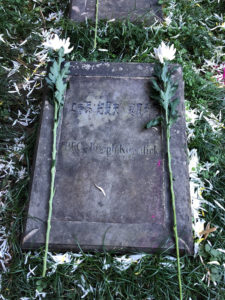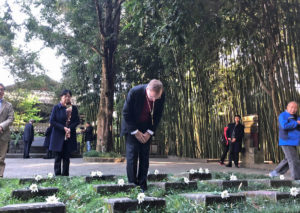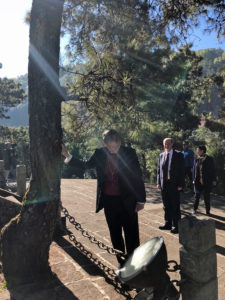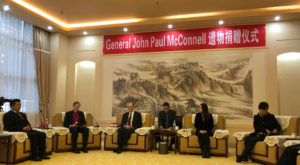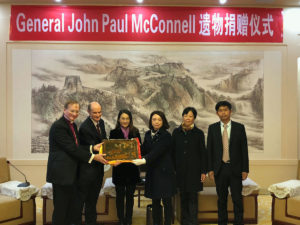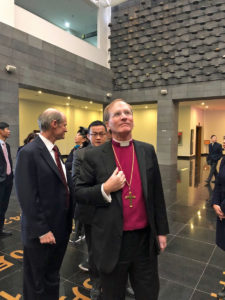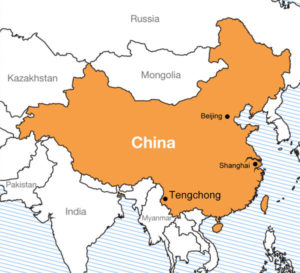Friday, December 8, 2017
The Church in China is booming.
On my last day, I paid a visit to the headquarters of the government department that oversees all officially sanctioned religious activity in China, called the Three Self Patriotic Movement (TSPM). In order to receive license to function openly, in addition to being vetted to ensure they pose no threat to the State, religious organizations must be self-governing, self-supporting and self-propagating. These criteria came into being when the TSPM was originated in 1952, to ensure that foreign religious entities (e.g. the Vatican) would not interfere in Chinese affairs, and that religious activity would not undermine the goals of socialism.
The TSPM has had its ups and downs. Churches were tolerated or suppressed at different periods, crushed during the Cultural Revolution from 1966 to 1976, allowed to grow beginning in 1979, and treated with a strange mix of encouragement and disapproval since the 1990s. On the one hand, there has been an exponential growth in “underground churches” – a house-church movement with Baptist and Pentecostal roots that is illegal and severely opposed by the government. On the other hand, with China’s transition to a hybrid economy, there is a renewed emphasis on moral education, and the government appreciates the possibilities offered by “official churches” to strengthen the spiritual and ethical fabric of the nation.
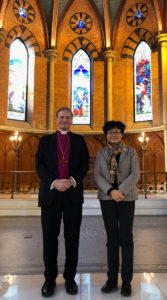 I knew some of this before my meetings in Shanghai. I had travelled to Guangzhou fifteen years ago as part of a study tour, and learned a fair amount about the Church in China. What I did not know was the extent of the growth and the increased security of the churches’ official position. This became apparent when I met with the Reverend Dr. Melissa Lin, the Deputy Head of the China Christian Council (CCC), and her assistant Meiying Shi. Dr. Lin is also dean of the seminary in Nanjing, the country’s largest. Her MDiv is from an Episcopal Seminary, the Church Divinity School of the Pacific, and she has a PhD from the Graduate Theological Union in Claremont, California.
I knew some of this before my meetings in Shanghai. I had travelled to Guangzhou fifteen years ago as part of a study tour, and learned a fair amount about the Church in China. What I did not know was the extent of the growth and the increased security of the churches’ official position. This became apparent when I met with the Reverend Dr. Melissa Lin, the Deputy Head of the China Christian Council (CCC), and her assistant Meiying Shi. Dr. Lin is also dean of the seminary in Nanjing, the country’s largest. Her MDiv is from an Episcopal Seminary, the Church Divinity School of the Pacific, and she has a PhD from the Graduate Theological Union in Claremont, California.
The CCC is the umbrella organization for all the recognized churches in China. I did not ask for the number of congregations, but the “official” estimate of Chinese Christians is about forty million and growing. This does not include members of underground churches, so the actual number could be nearly twice that. There are 23 established seminaries. A state-of-the-art plant in Nanjing is printing Bibles at capacity, and still cannot keep up with demand.
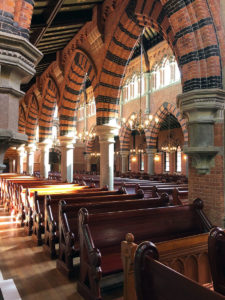 After our conversation, I was given a tour of the church next door, the former Holy Trinity Anglican Cathedral. Neglected for years, it has now been meticulously restored, including stained glass windows in the apse donated by the Episcopal Church. The renovation has won a UNESCO world heritage award, and the CCC hopes to plant a worshiping congregation here next year.
After our conversation, I was given a tour of the church next door, the former Holy Trinity Anglican Cathedral. Neglected for years, it has now been meticulously restored, including stained glass windows in the apse donated by the Episcopal Church. The renovation has won a UNESCO world heritage award, and the CCC hopes to plant a worshiping congregation here next year.
Over lunch, Dr. Lin and I talked about the challenges facing the Church here, the two largest being ecclesiology and liturgy. The CCC is officially “post-denominational.” They call themselves Christians, not Baptist or Methodist or Presbyterian. However, those churches which had been planted by missionaries before the revolution still retain something of the flavor of the denominations that founded them. Worship in a formerly Presbyterian church may still feel markedly Presbyterian, for example. It is no surprise that with so many doctrinal and liturgical streams flowing together into one huge lake, it is a real challenge to bring about a common understanding of the marks of the Church, or a common liturgical practice.
Of course, I found myself volunteering to help. Dr. Lin smiled. In China, she said, we think it important to make friendships first, before we embark on any projects together. Americans always want to sign contracts right away. That’s not our style. She offered one of the marvelous dishes on the table in front of us. Would you care for more fish, she asked. I appreciated the gentle reproof, and had to laugh at myself for being a “typical American.”
Nevertheless, we did discuss the possibility of my leading a trip back to China in 2019, and I am thinking specifically of bringing a team from the diocese including some of our younger clergy. I think they would benefit greatly from the experience of seeing what mission looks like from a “post-denominational Church,” particularly in the context of a secular and sometimes hostile culture.

